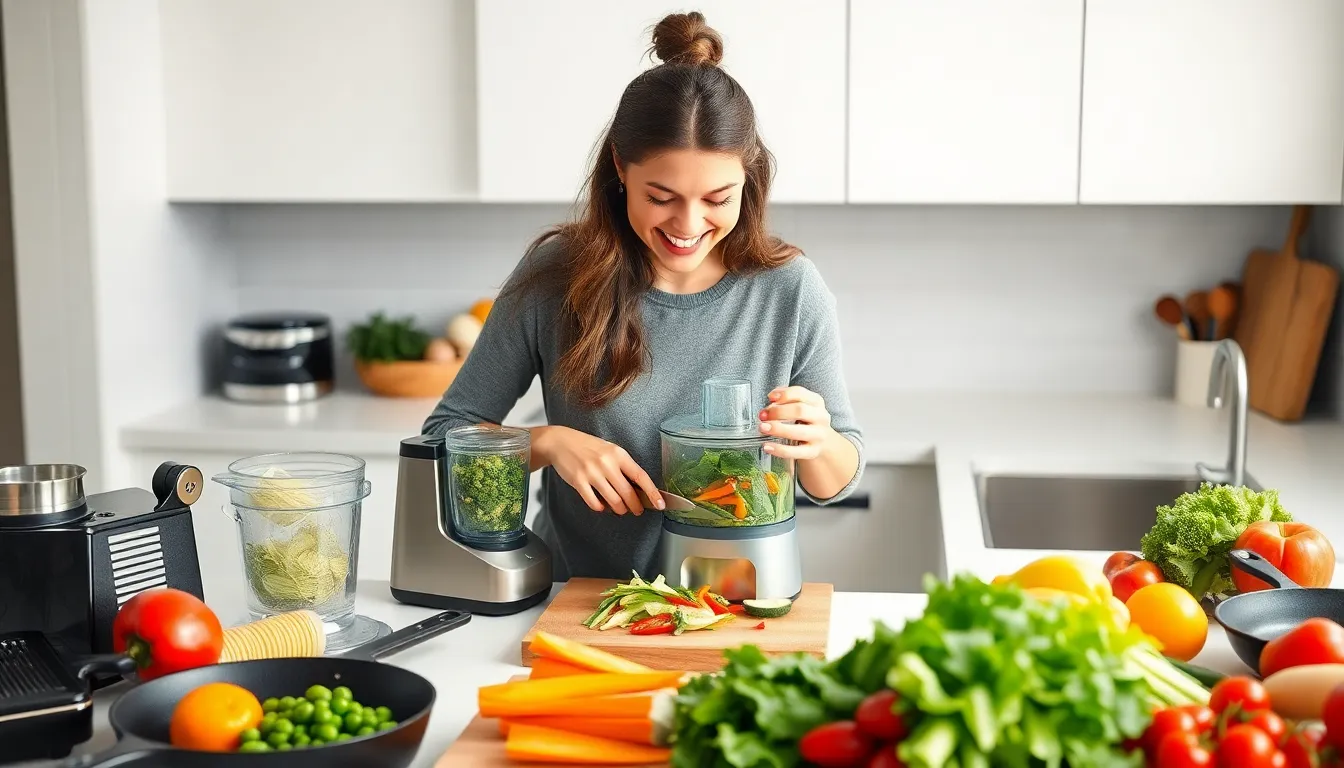In a world where plant-based diets are gaining momentum, mastering the art of vegetarian cooking can transform everyday meals into vibrant culinary experiences. Whether someone is a seasoned vegetarian or just exploring meatless options, clever kitchen hacks can elevate their cooking game and simplify meal prep.
From maximizing flavors with herbs and spices to creatively using leftovers, these tips not only save time but also enhance the nutritional value of dishes. Embracing these vegetarian kitchen hacks opens up a world of possibilities, making it easier to whip up delicious, wholesome meals that everyone will love.
Table of Contents
ToggleOverview of Vegetarian Kitchen Hacks
Vegetarian kitchen hacks streamline meal preparation and enhance flavor. These practical tips empower cooks to save time and create nutritious dishes.
Flavor Enhancement
- Herbs and Spices: Incorporate fresh herbs, such as basil or cilantro, and spices like cumin or paprika. These ingredients elevate flavors in dishes, making them vibrant and exciting.
- Marinating: Use marinades to infuse plant-based proteins, such as tofu or tempeh, with taste. A mixture of soy sauce, garlic, and ginger serves as an effective marinade.
Efficient Cooking Techniques
- Batch Cooking: Prepare large quantities of grains or legumes at once. Store portions in the fridge or freezer for quick meal assembly throughout the week.
- One-Pot Meals: Choose recipes that combine multiple ingredients in one pot. This method reduces cleanup and allows flavors to meld beautifully.
Utilizing Leftovers
- Creative Repurposing: Transform leftover roasted vegetables into soups or frittatas. This technique minimizes waste and maximizes creativity in meal options.
- Stock Creation: Accumulate vegetable scraps to create homemade vegetable stock. This enhances future dishes and utilizes every part of the produce.
Time-Saving Tools
- Food Processor: Use a food processor to quickly chop vegetables or create purees. This tool saves time on prep work, making cooking more efficient.
- Instant Pot: Utilize an Instant Pot for quick cooking of legumes, grains, and stews. This device reduces cooking times significantly while maintaining flavor and texture.
By integrating these vegetarian kitchen hacks, cooks can optimize their time in the kitchen and enjoy diverse, satisfying meals.
Essential Tools for a Vegetarian Kitchen

Equipping a vegetarian kitchen with the right tools enhances cooking efficiency and creativity. Essential gadgets and cookware can significantly streamline meal preparation and elevate dishes.
Must-Have Kitchen Gadgets
- Food Processor: A versatile food processor quickly chops, shreds, and purées vegetables, making it indispensable for preparing pesto, hummus, and other dips.
- Mandoline: A mandoline slicer creates uniform vegetable slices, perfect for salads, gratins, and stir-fries.
- Spiralizer: A spiralizer transforms vegetables into noodle shapes, offering a fun, low-carb alternative for pasta dishes.
- Immersion Blender: For soups and smoothies, an immersion blender easily blends ingredients without transferring them to a countertop blender.
- Instant Pot: An electric pressure cooker speeds up cooking time for beans and grains, and it also simplifies one-pot meal preparation.
Recommended Cookware
- Cast Iron Skillet: A cast iron skillet retains heat efficiently, ideal for sautéing and baking casseroles, while also adding a depth of flavor.
- Non-Stick Frying Pan: A high-quality non-stick frying pan ensures easy cooking and cleanup, particularly useful for delicate items like scrambled tofu or vegetable omelets.
- Stock Pot: A large stock pot is essential for creating soups and stews, allowing ample room for cooking large batches of plant-based broths and sauces.
- Baking Sheet: A sturdy baking sheet enables even roasting of vegetables, enhancing flavors through caramelization and making meal prep more productive.
- Steamer Basket: A steamer basket retains nutrients in vegetables by cooking them gently, providing a quick way to prepare healthy sides.
Time-Saving Techniques
Time-saving techniques streamline vegetarian meal preparation and enable efficient cooking. Employing these methods allows for quicker, more enjoyable cooking experiences.
Meal Prepping Tips
- Batch cooking: Prepare large portions of staple ingredients like grains, legumes, and vegetables. Store them in the refrigerator or freezer for quick access throughout the week. This reduces daily cooking time and maximizes meal variety.
- Use labeled containers: Organize prepped ingredients in clear, labeled containers. This makes finding items easier and helps maintain an organized kitchen space.
- Create a meal plan: Design a weekly meal plan outlining recipes and ingredient lists. This approach saves time spent deciding what to cook each day and ensures essential items are ready.
- Chop vegetables in advance: Wash, peel, and chop vegetables ahead of time. Store them in airtight containers for quick use in meals or snacks later.
- Marinate proteins overnight: Marinate plant-based proteins like tofu and tempeh the night before. This enhances flavor and ensures they’re ready for cooking upon return from a busy day.
Quick Cooking Methods
- Pressure cooking: Utilize pressure cookers like Instant Pots to cook beans, grains, and stews in a fraction of the time. Pressure cooking retains flavors and nutrients while speeding up the cooking process.
- Stir-frying: Use stir-frying techniques for quick vegetable and protein combinations. The high heat ensures rapid cooking while enhancing flavors through caramelization.
- Microwaving: Microwave vegetables to maintain nutrients and flavor without the lengthy cooking times. This method proves efficient for steaming vegetables quickly.
- One-pan meals: Prepare one-pan meals to minimize cleanup time. Roast vegetables and proteins together on a single baking sheet, allowing flavors to meld while simplifying the cooking process.
- Blender soups: Create soups using a blender for a fast and easy meal. Cook vegetables briefly, blend with broth, and heat to enjoy a warm, nourishing dish.
Flavor Boosting Hacks
Maximize flavor in vegetarian dishes with simple techniques that highlight fresh ingredients. Emphasizing herbs, spices, and condiments enhances meals without extra effort.
Herbs and Spices for Vegetarians
Fresh herbs like basil, cilantro, and parsley elevate dishes with vibrant flavors. Utilize dried herbs, such as oregano and thyme, when fresh isn’t available. Cooking herbs and spices in oil extracts their essential oils, enhancing flavor. Toasting spices in a dry pan before use intensifies their aroma and adds depth to the taste. Blending herbs into sauces or pestos creates concentrated flavor boosts. Consider combining several herbs in dishes to create layered tastes that complement main ingredients.
Creative Condiment Uses
Condiments transform ordinary dishes into flavor-packed experiences. Incorporating sauces, like tahini, sriracha, or tamari, offers new dimensions to meals. Drizzling balsamic reduction over roasted vegetables enhances their natural sweetness. Using flavored oils, such as chili or garlic-infused oil, breathes new life into salads and grain bowls. Mixing yogurt with herbs and spices forms a zesty dip or dressing. Experimentation with unique condiments leads to unexpected pairings, making every meal a flavorful adventure.
Storage and Preservation Tips
Efficient storage and preservation techniques can extend the lifespan of vegetarian ingredients, ensuring freshness and minimizing waste. Implementing these hacks can significantly improve meal prep efficiency and flavor retention.
Keeping Produce Fresh
- Use breathable bags: Store fruits and vegetables in mesh or perforated bags to maintain airflow and reduce moisture buildup.
- Store herbs upright: Place fresh herbs in a jar with water, similar to a bouquet, to keep them vibrant and fresh for longer periods.
- Wrap leafy greens: Wrap greens in damp paper towels before placing them in a container to prevent wilting and maintain crispness.
- Utilize crisper drawers: Adjust humidity settings in refrigerator crisper drawers—keep vegetables in high humidity and fruits in low to prolong freshness.
- Freeze excess produce: Freeze items like surplus herbs, ripe bananas, or vegetables to preserve their nutrients and flavors for future use.
Storing Leftovers Effectively
- Choose air-tight containers: Use glass or BPA-free plastic containers with secure lids to minimize air exposure and enhance freshness.
- Label and date: Clearly label containers with contents and date stored to track freshness and prevent eating expired leftovers.
- Cool before storage: Allow leftovers to cool completely before sealing to avoid condensation, which can lead to sogginess and spoilage.
- Portion wisely: Store leftovers in meal-sized portions for quick access and reduced waste, ensuring easy reheating for future meals.
- Use the freezer wisely: Freeze leftovers within three days of cooking to maintain taste and quality, thawing when ready to enjoy.
Embracing vegetarian kitchen hacks can transform the way meals are prepared and enjoyed. By incorporating these practical tips and essential tools, anyone can elevate their cooking experience. From maximizing flavors with fresh herbs to efficiently managing meal prep, these strategies make plant-based cooking accessible and enjoyable.
With a focus on creativity and sustainability, these hacks not only save time but also enhance the nutritional value of dishes. By adopting these techniques, individuals can make the most of their ingredients while minimizing waste. Ultimately, a well-equipped vegetarian kitchen opens the door to a world of delicious and wholesome meals that cater to every palate.





